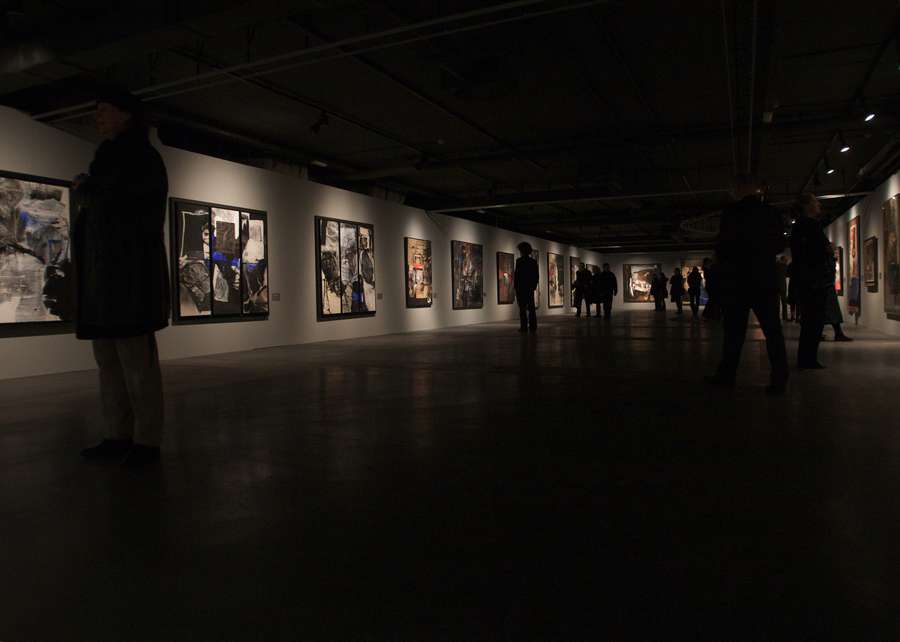Antoni Clavé: A World of Art. 1934–2002
The Jakopič Gallery, in coproduction with the State Corporation for Spanish Cultural Action Abroad (SEACEX) and the support of the Embassy of Spain in Slovenia, presents an overview of Antoni Clavé’s works selected from private collections especially for this exhibition.
The exhibition comprises artistic works such as collages, cinema posters, theatre sceneries and canvases; the works express the diverse creativity of the artist, who represented Spain at the 1984 Venice Biennale with a solo exhibition.
Antoni Clavé is one of the most famous pioneers of Spanish modernism with greatest international presence and outreach. He was born in Barcelona in 1913 and died in Saint-Tropez in 2005. His artistic education in his native town made him a witness of the final brilliant cusp of modernismo. His beginnings as draftsman in periodicals were outstanding, and soon he became a gifted movie posters designer. His posters show a skilled plastic syncretism, imbued with the sources of the avant-gardes which made the 20th Century so special: from cubism to futurism, expressionism and the aesthetics of graphic design. Clavé, marked by the Civil War, went into exile to France, where he discovered lithography and engravings, fields that would positively open the doors of the publishing world for him and that would turn him into a renowned illustrator. His publications Carmen by Merimée (1946) or Pushkin’s Dame de Pique are remarkable examples of this.
In 1942, his friendship with Picasso broke this intimate moment and for some years he devoted his work to the traditional genres of still life, landscape and portrait. This path led him to abstraction. By 1954, Clavé was a major name in the French visual arts. After a period of resounding international scenographic successes (La casa de Bernarda Alba, La peur, Deuil en 24 heures and his fortunate collaborations with Ruth Page for the Chicago Opera), devoted himself entirely to painting. He proved to be a master of the striking figurative iconography of commanding visual impact and an archaic air - bearded kings, elusive queens and anthropomorphic shapes of powerful significance. It this period he discovered - or, rather, revived the material aspect of his art. Clavé thus became an expert on textures, pigments and their visual derivations, subject to the light, which turned them into an ethereal atmosphere, always in formal opposition to pictorial rhythms.
In 1956 Antoni Clavé turned to the assemblage, glimpsed at the beginnings of the 1930’s, through a magnificent sequence of slightly surreal living objects (Homme au Monocle, Telephone, etc.). However, the leap from assemblage to collage marked a conscious pictorial re-approach that went beyond the merely technical. The collages of Clavé always respond to a strict expressive scheme and open his work to informalism. Nowadays, this is considered the most outstanding period of Clavé.
The great German epic Gottfried Benn said, “The morality of art is its form”. This is a proposition that Clavé was to embody in all his works.
Colophon
Project manager: Marija Skočir
Curator of the exhibition: José Francisco Yvars
Expertise: Marija Skočir
Coordination: Marija Skočir (MGML), Casilda Ybarra (SEACEX), Yasmín Martín Vodopivec (Spanish Embassy)
Setting up: Irena Šinkovec
Exhibition realization: Mapa, Technical Service MGML, RPS d.o.o., Strle Svetila
Conservation expertise: Katarina Toman Kracina
Graphic and exhibition design: Bojan Lazarevič (Agora Proars)
The project was made possible by: City of Ljubljana, Ministry of Culture of the Republic of Slovenia
Sponsors: Mobitel, TAM-TAM
Media sponsors: Dnevnik, Info TV
Location
Slovenska cesta 9
1000 Ljubljana
T +386 1 42 54 096
T +386 1 24 12 500
E galerija.jakopic@mgml.si
Opening hours
Tuesday–Sunday: 10 a.m.-6 p.m.
Monday: Closed
1 January, 1 November, 25 December: Closed
24 and 31 December: 10. a.m.-2 p.m.
Tickets
Adults: 5 €
Students, people over the age of 60, unemployed, people with disabilities: 3 €
Family ticket: 12 €
ICOM, PRESS, SMD, students of the Academy of Fine Arts and Design, VIST – Higher School of Applied Sciences, Faculty of Natural Sciences and Engineering – OTGO, Faculty of Design: Admission free
Guided tours of the exhibition: every Saturday at 4.30 p.m. (included in the admission fee)
Join the Friends of the Jakopič Gallery. The € 12 annual membership fee includes numerous benefits and exclusive events. Click here for more information.
